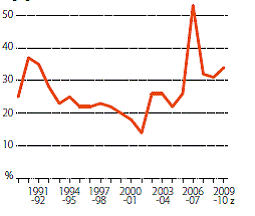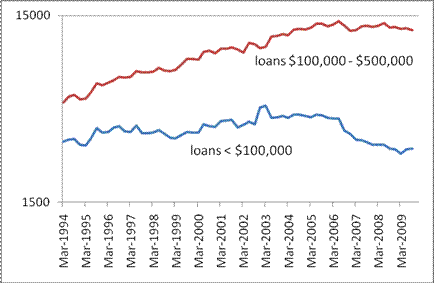Chapter 8
Rural finance
Introduction
8.1
Farmers are an important category of small business and the discussion
in the previous chapters is relevant to them. For example, like other small businesses
they emphasised the issue of competition:
...the need to ensure that there is competition within the
marketplace. I think that is one of the key elements here.[1]
8.2
This chapter discusses some issues specific to the rural sector. Its
importance is underscored by the fact that interest and fertiliser are the two
largest costs for farmers.[2]
The average farm has over $400,000 in debt.[3]
Farmers surveyed by ABARE in November 2009 expected to increase debt by 4-5 per
cent on average in 2009-10.[4]
8.3
The temporary reduction in interest rates to unusually low levels
following the global financial crisis has given farmers some breathing space
but debt servicing ratios are again rising as interest rates normalise and debt
continues to grow (Chart 8.1).
Chart 8.1: Debt
servicing ratio, broadacre and dairy farms

Source: P Martin et al, Australian farm survey results, 2007-08 to
2009-10, ABARE, April 2010, p. 21.
Lending to the rural sector
8.4
Banks' outstanding credit to smaller borrowers in the rural sector has
declined somewhat in recent years (Chart 8.2). The decline, however, predated
the global financial crisis.
Chart 8.2: Banks'
credit to the rural sector
$ million, logarithmic
scale

Source: Secretariat based on APRA data reported on www.rba.gov.au,
Bulletin table D7.
8.5
There has also been some change in the reasons for borrowing:
Increases in land purchase debt are confined to a relatively
small proportion of farms. However, in recent years there has been a
substantial increase in debt to fund working capital as many farms have had low
cash incomes because of adverse seasonal conditions. In contrast to increases
in land purchase debt, increased borrowing for working capital has occurred
across a high proportion of farms. In 2006-07, 60 per cent of the total
increase in broadacre farm debt was to fund working capital.[5]
8.6
Until recently farmers had found it easy to borrow:
... since 2003 farm debt has increased by 83 per cent... Obviously
credit and money has been relatively easy to obtain over the last four to five
years and farmers have invested in that environment quite substantially.[6]
8.7
The problem had more been around ability to repay the debt taken on:
The big problem for agriculture has been that, whilst we have
incurred substantial debt to maintain that productivity growth, the profits to
underpin that investment have not necessarily come back to the farm sector.[7]
8.8
More recently the concern has shifted to availability of finance:
The NFF has received information from members that credit
access has tightened.[8]
Until they readjust to the new rules with a shortage of
finance—tight money—things are going to be fairly tight in a lot of
agricultural enterprises...[9]
8.9
The NFF was at pains not to overstate the problem at the hearing:
...there are examples of finance being difficult to obtain. I
would not suspect that it was a national epidemic. I would suspect that there
was still the ability to obtain finance, but there have been some negative
impacts from what has happened over the last 12 months....[10]
8.10
Asked about this weakness in rural lending, bankers replied:
There may be regional variations and that can sometimes be
attributed to long-term drought in some areas. It is difficult to get credit
and access if farming businesses have been in financial difficulty for some
time.[11]
8.11
The Committee heard that wheat farmers in Western Australia are facing
particular difficulties in getting finance. The banks attributed this to low
wheat prices:
We have no difference in approach across the country. We have
a segment approach—so, we have an approach to the wheat sector and the meat
sector. Geography is relevant: there has been less rain in WA than there has
been in other parts, but it is certainly no dryer than New South Wales has
been. So we do not have any specific policies that make it any different for a
Western Australian farmer to borrow than for a New South Wales, Queensland or
Victorian farmer...a lot of people believe that the wheat price is headed towards
$150 a tonne. It costs them around about $160 to produce that wheat. So they
are resorting to on-farm storage, which they have not done for a long time, and
the result of that is that customers will be sitting on their stock and not
selling, so they will have no cash flow through the business.[12]
8.12
A problem identified by the Committee was that when a farm is struggling
due to drought or low commodity prices, the bank views loans to it as having
become more risky. It therefore, prudently from its point of view, wants to
charge a higher interest rate to compensate for the higher risk of default. The
problem, however, is that the higher interest rate may itself make the default
more likely.
8.13
Responding to this concern a farmers' representative called for the
banks to take a more medium-term perspective:
...they should probably be looking to reduce the margin for a
period of time that allows some breathing space to get the business back to
full production at a lot quicker rate.[13]
8.14
Another problem noted by the Committee was that the Reserve Bank
effectively has only one policy instrument – its policy interest rate – which
it has to set based on the 'average speed' of a 'two-speed' economy, where the
mining sector may be overheating while the agricultural sector is struggling:
There are a lot of people not only in agriculture but also in
other small businesses and other industries who are astounded at what is
described as the two-speed economy in which there is this exceptional growth
currently, which necessitates the interest rates going up on a regular basis, whereas
a lot of those people and industries are still endeavouring to recover from the
negative impact of the global financial crisis. Again, there is no silver
bullet...[14]
8.15
The NFF had some positive views about bank performance:
By and large, Australian banks have been very supportive of
Australian farmers in the last 10 years, in particular through, as most of you
would be aware, one of the worst droughts that this country has ever seen. Bank
practices are now a lot more balanced and considered. The horror stories of the
eighties and early nineties of mass foreclosures are now the exception rather
than the norm. So the relationship between the finance sector and agriculture
is good one; however, there is always room for improvement.[15]
8.16
Establishing a rural bank attracted only lukewarm interest:
I would not discount looking at a primary industries bank,
but I think we need to explore some other avenues through various legislation,
through various competition and transparency issues, to see if that rectifies
the problem.[16]
Suggested responses
8.17
Around 22 per cent of farms use farm management deposits and the average
value is around $28,000.[17]
Farmers see them as useful:
Farm management deposits have been a really successful
mechanism for the farming community and we believe they have been a very
effective risk management tool to adjust to those big fluctuations in annual
income that the farm community experiences. Any way that we can build up the
support behind those farm management deposits is very welcome.[18]
8.18
They could, however, be improved:
Perhaps if they were more applicable to a wide range of
businesses, a wider range of businesses would then take them up, particularly
in Western Australia with their larger farm sizes. As we go forward, and I
suspect it is the same for all Australian farms of larger farm size, the
$400,000 figure is not going to be adequate on a multiyear scale.[19]
... one of the bigger limiting factors on the use of FMDs is
the fact that they can only be utilised by an individual. Many of Australia’s
farmers still operate under a family regime. [20]
8.19
A suggestion to ease financial pressures, made by the NSW Farmers'
Federation, is the introduction of a "first farm grant", analogous to
the first home owner grant, to assist young people to make a career on the land.
This could, for example, involve the government paying young farmers a tenth of
the cost of buying a farm up to a limit of, say, $100,000.[21]
A possible concern is that, as with the home buyers' grants, such a scheme may
just push up the price of smaller farms.
Committee view
8.20
The Committee notes that farmers comprise an important class of small
business and have had difficulty attracting credit to tide themselves through
droughts or periods of low prices.
Navigation: Previous Page | Contents | Next Page